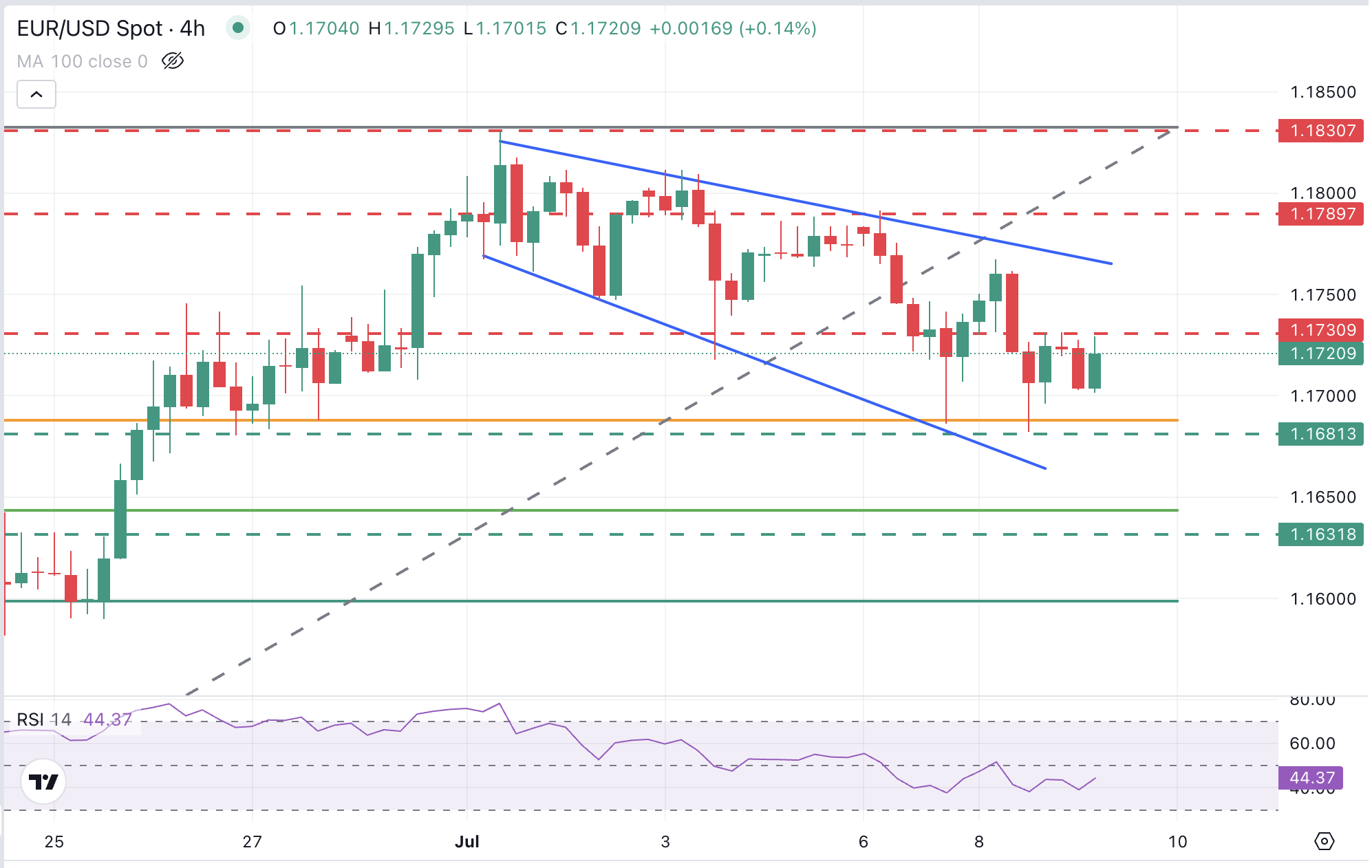Created
: 2025.07.09














![]() 2025.07.09 17:09
2025.07.09 17:09
The EUR/USD pair is practically flat on Wednesday, near the bottom of the weekly range, as investors remain wary of risk after US President Donald Trump announced new tariffs on copper and pointed to significant restrictions on pharmaceuticals.
The Euro (EUR) found support at the 1.1700 area on Wednesday's Asian session after rejection at 1.1770 on the previous day, and is currently trading at 1.1730 in the early European session. The broader trend, however, remains bearish, with the pair correcting after a more than 2% rally in late June.
Trump took his trade war to the next stage after announcing 50% tariffs on imports of copper products and threatening a 200% levy on drugs if pharmaceutical firms do not relocate their production to the US within the next 12 months.
These measures come less than 24 hours after the US imposed 25% tariffs on Japan and Korea, the country's second and third major Asian partners. The deadline for their application was delayed to August 1, and US Government officials left a door open to adjustments if trading partners send their proposals, which contributed to easing the risk-averse reaction to the new tariffs.
In a more domestic scope, the trade negotiations between the Eurozone and the US do not seem to be at their best moment. Eurozone sources continue to express hopes of reaching a deal that will spare them from the 10% baseline levy, but Trump affirmed that he will send a tariff letter to the European Union this week. Not the best news for the Euro.
The table below shows the percentage change of Euro (EUR) against listed major currencies today. Euro was the strongest against the Japanese Yen.
| USD | EUR | GBP | JPY | CAD | AUD | NZD | CHF | |
|---|---|---|---|---|---|---|---|---|
| USD | 0.07% | 0.04% | 0.28% | 0.12% | 0.03% | 0.02% | 0.02% | |
| EUR | -0.07% | -0.02% | 0.19% | 0.05% | -0.00% | -0.06% | 0.07% | |
| GBP | -0.04% | 0.02% | 0.24% | 0.07% | -0.07% | -0.10% | -0.01% | |
| JPY | -0.28% | -0.19% | -0.24% | -0.18% | -0.24% | -0.26% | -0.23% | |
| CAD | -0.12% | -0.05% | -0.07% | 0.18% | -0.03% | -0.10% | 0.04% | |
| AUD | -0.03% | 0.00% | 0.07% | 0.24% | 0.03% | -0.06% | 0.08% | |
| NZD | -0.02% | 0.06% | 0.10% | 0.26% | 0.10% | 0.06% | 0.09% | |
| CHF | -0.02% | -0.07% | 0.00% | 0.23% | -0.04% | -0.08% | -0.09% |
The heat map shows percentage changes of major currencies against each other. The base currency is picked from the left column, while the quote currency is picked from the top row. For example, if you pick the Euro from the left column and move along the horizontal line to the US Dollar, the percentage change displayed in the box will represent EUR (base)/USD (quote).

EUR/USD recovery attempt was limited right below the descending trendline resistance from July 1 highs, at the 1.1770 area, which keeps the price action within a broadening wedge pattern. This figure reveals an emotional market, often appearing at major tops.
Technical indicators are on bearish territory, with the Relative Strength Index (RSI) wavering below the 50 level on the 4-hour chart, although the support area above 1.1680, where the 38.2% Fibonacci retracement level of the June 24 - July 1 rally meets the July 7 and 8 lows, seems a strong support level.
Below here, the pair might find support at 1.1630 - 1.1645, where previous highs meet the 50% Fibonacci retracement level of the mentioned late June rally.
On the upside, immediate resistance is the intraday high, at 1.1730, ahead of the mentioned trendline and the July 8 high at the 1.1765-1.1770 area.
Tariffs are customs duties levied on certain merchandise imports or a category of products. Tariffs are designed to help local producers and manufacturers be more competitive in the market by providing a price advantage over similar goods that can be imported. Tariffs are widely used as tools of protectionism, along with trade barriers and import quotas.
Although tariffs and taxes both generate government revenue to fund public goods and services, they have several distinctions. Tariffs are prepaid at the port of entry, while taxes are paid at the time of purchase. Taxes are imposed on individual taxpayers and businesses, while tariffs are paid by importers.
There are two schools of thought among economists regarding the usage of tariffs. While some argue that tariffs are necessary to protect domestic industries and address trade imbalances, others see them as a harmful tool that could potentially drive prices higher over the long term and lead to a damaging trade war by encouraging tit-for-tat tariffs.
During the run-up to the presidential election in November 2024, Donald Trump made it clear that he intends to use tariffs to support the US economy and American producers. In 2024, Mexico, China and Canada accounted for 42% of total US imports. In this period, Mexico stood out as the top exporter with $466.6 billion, according to the US Census Bureau. Hence, Trump wants to focus on these three nations when imposing tariffs. He also plans to use the revenue generated through tariffs to lower personal income taxes.
![]()
Created
: 2025.07.09
![]()
Last updated
: 2025.07.09

FXStreet is a forex information website, delivering market analysis and news articles 24/7.
It features a number of articles contributed by well-known analysts, in addition to the ones by its editorial team.
Founded in 2000 by Francesc Riverola, a Spanish economist, it has grown to become a world-renowned information website.
We hope you find this article useful. Any comments or suggestions will be greatly appreciated.
We are also looking for writers with extensive experience in forex and crypto to join us.
please contact us at [email protected].
Disclaimer:
All information and content provided on this website is provided for informational purposes only and is not intended to solicit any investment. Although all efforts are made in order to ensure that the information is correct, no guarantee is provided for the accuracy of any content on this website. Any decision made shall be the responsibility of the investor and Myforex does not take any responsibility whatsoever regarding the use of any information provided herein.
The content provided on this website belongs to Myforex and, where stated, the relevant licensors. All rights are reserved by Myforex and the relevant licensors, and no content of this website, whether in full or in part, shall be copied or displayed elsewhere without the explicit written permission of the relevant copyright holder. If you wish to use any part of the content provided on this website, please ensure that you contact Myforex.
Myforex uses cookies to improve the convenience and functionality of this website. This website may include cookies not only by us but also by third parties (advertisers, log analysts, etc.) for the purpose of tracking the activities of users. Cookie policy